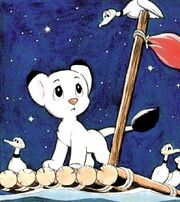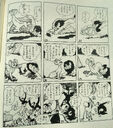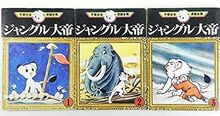
Janguru Taitei [ジャングル大帝] (Jungle Emperor) was a serial manga by Osamu Tezuka first published between November 1950 and April 1954 in the monthly Manga Shonen. It is the basis of Kimba the White Lion, Leo the Lion (Onward, Leo!), The New Adventures of Kimba the White Lion (Jungle Emperor 1989), and Jungle Emperor Leo. This manga series has not yet been released in English in its entirety.
Jungle Emperor is Osamu Tezuka's most popular works. The story elements and plots take place back-after-back-after-back, which is a common occurrence in Osamu Tezuka's early works of manga. There are two main versions of the manga: the original 50s version and the three-volume 1977 "Complete Works" reprint that is most widely referenced and printed today.
History[]
Osamu Tezuka had planned the manga originally as a one–shot titled Mitsurin Taitei [密林大帝] – literally “Dense Forest Emperor”. Then, publisher Kenichi Kato convinced the then young Osamu Tezuka to expand on his idea and change it to a four–page feature in the monthly Manga Shonen. The manga debuted in November 1950 with a new name, titled, Junguru Taitei [ジャングル大帝], or “Jungle Emperor”, which sounded more exotic and eye-catching. The manga was extremely popular from the get-go and the manga expanded to ten pages the next issue in December.
National Broadcasting Company (NBC) approached Osamu Tezuka in late 1964 for a television series, after the success of the previous series, Astro Boy (1963), and was trilled to pitch the series to them.
During production of the television series, some of the original artwork was lost due a studio staff member stealing/"borrowing" some of the artwork pages and taking it to his apartment, wanting to reference the work. The staff member had unexpectedly passed away and police had cleared out the staff member's apartment, taking the original artwork in the process. Tezuka had tried to rush to the man's apartment once he had realized that the staff member had the artwork, but it was already too late. While back-ups of the prints existed and were still recoverable, printing plates were extremely expensive at the time. Therefore, the original version remained lost to the public for many years.
Original 50s Version[]

Bubu and Zilba Collaborating - one of the many examples of '50s panels that are missing in the '77 version

One of the Original Artwork Pieces
The original version that was released as a serial manga between November 1950 and April 1954 is often referred to as the 50s version of the manga. The unedited original is often referred to as, "Manga Shonen Jungle Emperor".
In 2009, the original 1950s version was restored using secondary sources twenty years after Osamu Tezuka's death. This release is known as the Manga Shonen Deluxe Limited Edition (漫画少年版 ジャングル大帝 豪華限定版) This was possible due to the progression of digital technology. This version has been reissued in 2010 (Manga Shonen Popular Edition (漫画少年版 ジャングル大帝 普及版)) with a few pages in color.
Tezuka had edited his manga many times up to the last release of the manga before his death in 1989. For example in 1958-59, a reissue of the 1950 serial manga was released known as "The Kobunsha Edition" (ジャングル大帝 光文社版). Tezuka had colorized some pages of his original artwork and expanded on many scenes to help with pacing. This version was also given a release in 2016.
1977 Complete Works Edition[]

three-volume set
Complete Manga Works Edition or also known as the 70s version is a semi-redrawn print of the manga. At the time, Tezuka had to re-draw the missing portions of the artwork in order to re-release the Jungle Emperor manga in a book format. The re-drawn portions were based on The Kobunsha Edition and subsequent releases of the manga for the expanded scenes.
Differences[]
- There are style changes in the panels that were re-drawn. This is because Tezuka was trying to replicate his style that was drawn 15 years prior.
- Tezuka often tweaked his original work if he had an opportunity to improve in new editions and reprints. He redrew a significant portion of the series, certain aspects of the story were changed, expanded, moved around or deleted entirely. For example, some panels have events that occur earlier, later, or in entirely new chapters.
This version had been used in all of the translations and most subsequent reprints of the manga.
Known Releases[]
| Release Date | Type | Volumes | Publisher | Notes |
|---|---|---|---|---|
| Nov. 1950 -
April 1954 |
Manga Shōnen | Serialization | Gakudō-sha | (Also released in book format) 
|
| Sept. 1958 -
May 1959 |
Manga Complete Works | 4 | Kobunsha | Incomplete (3/4 of story) - More panels for pacing (partial color)
|
| Aug. 1964 -
Sept. 1965 |
Disneyland Magazine Comics | (14 issues) | Kodansha | First half of manga with a diverting plot
|
| Jan. 1966 -
Feb. 1967 |
Sunday Comics | 5 | Shogakukan | More Expansion and changes (partial color)
|
| Dec. 1969 -
Feb 1970 |
Tezuka Complete Works (Golden Comics) | 3 | Shogakukan | 
|
| Oct. 1971 -
April 1972 |
"Tezuka Magazine Leo"
Oct - April Issue |
(7 issues) | Mushi Pro Trading |    
|
| Feb. 1, 1976 | Vol 2. Tezuka Works | 1 | Bunminsha | 
|
| June - Aug. 1977 | Tezuka Osamu Manga Complete Works | 3 | Kodansha | Most Popular Release  
|
| June 25, 1980 | 2 | Master Publication Association | Reprint of the Original | |
| June 1, 1982 | Tezuka Holup Collection | 2 | Holup Publishing | Released with other stories
|
| January 1, 1984 | Tezuka Osamu Works Collection | 1 (in 11-vol. set) | Midori Yangsha | (Last release when Tezuka was alive - no more edits) 
|
| Jan. - Feb. 1990 | Nora Comics Deluxe | 2 | Gakken | Released alongside the 1989 series
|
| Aug. 1990-
March 1992 |
Gourd Tsugi Times | Issue 28-32 | Tezuka Osamu Fan Club Kyoto | Limited and exclusive release (1950 Manga Shonen re-release) |
| August 1997 | 2 | Shogakukan | Hardback 
| |
| August 1999 | Shogakkan Library | 2 | Shogakukan | Pocket edition 
|
| May 2008 | Tezuka WORLD Manga Shonen | ? | Sesame Books | Partial Release
|
| Oct. 2009 | 2 | Kodansha | Physical and Digital 
| |
| Dec. 2009 | Manga-Shonen Deluxe Limited Edition | 2 | Shogakukan | Original re-release - BoxHardcover, few color pages 
|
| Mar. 2010 | Manga-Shonen Popular Edition | 2 | Shogakukan | Original re-release - few color pages 
|
| Feb. 2012 | 3 | Bitway | E-Book  
| |
| April 2014 | Color comics original collection | 1 | Juritsusha | Some manuscripts in color or the first time
|
| Apr. - Oct. 2016 | 4 | Revived.com | "Kobunsha Edition"
re-print - Hard Covers | |
| June 2016 | Osamu color work anthology | 1 | Kokusho | "Disneyland comics edition" re-release with other Tezuka stories 
|
| May 10, 2019 | Tezuka's "Best Of"
Collection |
2 | Goma Books | Tezuka's 90th anniversary
|
| Feb. 2020 | Tezukomi vol. 17 | 1 issue | Micro Magazine Company | 
|
Chapters[]
Book 1[]
- 0. The Death of Panja
- 1. The Birth of Leo
- 2. In Aden (Port town in present-day Yemen)
- 3.The Secret of the Moonlight Stone
- 4.The First Steps into Africa
- 5. A Jungle Symphony
Book 2[]
- 6. The Legend of Androcles
- 7. Queen Conga
- 8. On the Banks of the Donga River
- 9. Conga's tears
- 10. The Battle
- 11. Little Ones
- 12. Leaving the Native Land
- 13. A man named Adam Dandy
Book 3[]
- 14. The Castle
- 15. In New York
- 16. The Great Plague
- 17. The Mt. Moon Files
- 18. Rune returns home
- 19. The Big Crevasse
- 20. Mountain Dangers
- 21. Epilogue
Trivia[]
- It has been re-released in Japan several times, and has also been translated and published in German, Italian, French, Portuguese, Finnish, and Chinese. In 2013, a bilingual Japanese-English release of the manga (containing only the first volume of the manga) has been released in Japan.

Gallery[]
Resources[]
- Most of History taken from: (Further Reading) - TezukaInEnglish - TezukaOsamu.net
- Article on 2016 reissue of Kobunsha (50s) Edition
- Release Archive - Phoenix.to







